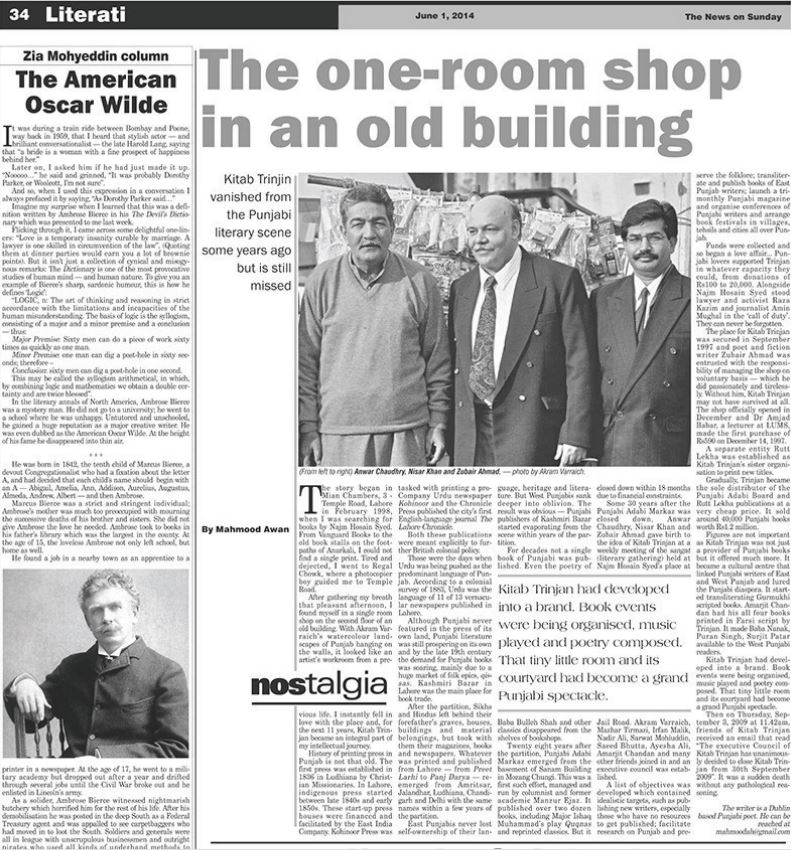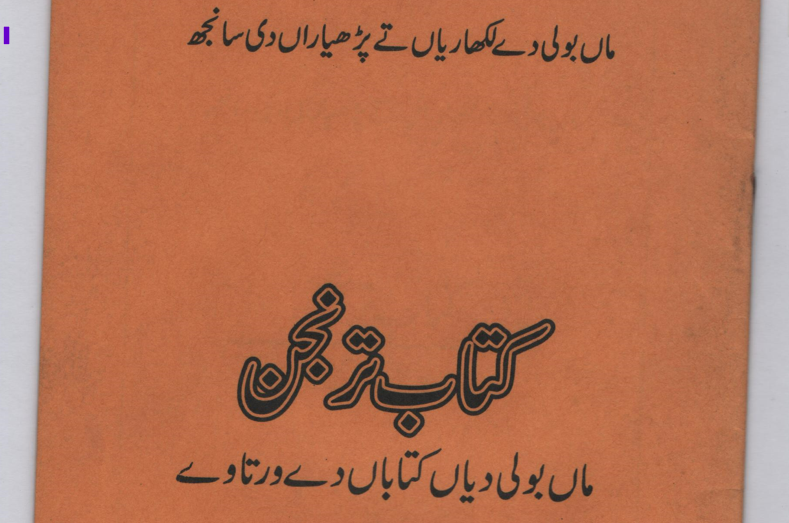The story began in Mian Chambers, 3 – Temple Road, Lahore in February 1998, when I was searching for books by Najm Hosain Syed. From Vanguard Books to the old book stalls on the footpaths of Anarkali, I could not find a single print. Tired and dejected, I went to Regal Chowk, where a photocopier boy guided me to Temple Road.
After gathering my breath that pleasant afternoon, I found myself in a single room shop on the second floor of an old building. With Akram Varraich’s watercolour landscapes of Punjab hanging on the walls, it looked like an artist’s workroom from a previous life. I instantly fell in love with the place and, for the next 11 years, Kitab Trinjan became an integral part of my intellectual journey.
History of printing press in Punjab is not that old. The first press was established in 1836 in Ludhiana by Christian Missionaries. In Lahore, indigenous press started between late 1840s and early 1850s. These start-up press houses were financed and facilitated by the East India Company. Kohinoor Press was tasked with printing a pro-Company Urdu newspaper Kohinoor and the Chronicle Press published the city’s first English-language journal The Lahore Chronicle.
Both these publications were meant explicitly to further British colonial policy.
Those were the days when Urdu was being pushed as the predominant language of Punjab. According to a colonial survey of 1883, Urdu was the language of 11 of 13 vernacular newspapers published in Lahore.
Although Punjabi never featured in the press of its own land, Punjabi literature was still prospering on its own and by the late 19th century the demand for Punjabi books was soaring, mainly due to a huge market of folk epics, qissas. Kashmiri Bazar in Lahore was the main place for book trade.
After the partition, Sikhs and Hindus left behind their forefather’s graves, houses, buildings and material belongings, but took with them their magazines, books and newspapers. Whatever was printed and published from Lahore — from Preet Larhi to Panj Darya — re-emerged from Amritsar, Jalandhar, Ludhiana, Chandigarh and Delhi with the same names within a few years of the partition.
East Punjabis never lost self-ownership of their language, heritage and literature. But West Punjabis sank deeper into oblivion. The result was obvious — Punjabi publishers of Kashmiri Bazar started evaporating from the scene within years of the partition.
For decades not a single book of Punjabi was published. Even the poetry of Baba Bulleh Shah and other classics disappeared from the shelves of bookshops.
Twenty eight years after the partition, Punjabi Adabi Markaz emerged from the basement of Sanam Building in Mozang Chungi. This was a first such effort, managed and run by columnist and former academic Manzur Ejaz. It published over two dozen books, including Major Ishaq Muhammad’s play Quqnas and reprinted classics. But it closed down within 18 months due to financial constraints.
Some 30 years after the Punjabi Adabi Markaz was closed down, Anwar Chaudhry, Nisar Khan and Zubair Ahmad gave birth to the idea of Kitab Trinjan at a weekly meeting of the sangat (literary gathering) held at Najm Hosain Syed’s place at Jail Road. Akram Varraich, Mazhar Tirmazi, Irfan Malik, Nadir Ali, Sarwat Mohiuddin, Saeed Bhutta, Ayesha Ali, Amarjit Chandan and many other friends joined in and an executive council was established.
A list of objectives was developed which contained idealistic targets, such as publishing new writers, especially those who have no resources to get published; facilitate research on Punjab and preserve the folklore; transliterate and publish books of East Punjab writers; launch a tri-monthly Punjabi magazine and organise conferences of Punjabi writers and arrange book festivals in villages, tehsils and cities all over Punjab.
Funds were collected and so began a love affair… Punjabi lovers supported Trinjan in whatever capacity they could, from donations of Rs100 to 20,000. Alongside Najm Hosain Syed stood lawyer and activist Raza Kazim and journalist Amin Mughal in the ‘call of duty’. They can never be forgotten.
The place for Kitab Trinjan was secured in September 1997 and poet and fiction writer Zubair Ahmad was entrusted with the responsibility of managing the shop on voluntary basis — which he did passionately and tirelessly. Without him, Kitab Trinjan may not have survived at all. The shop officially opened in December and Dr Amjad Babar, a lecturer at LUMS, made the first purchase of Rs590 on December 14, 1997.
A separate entity Rutt Lekha was established as Kitab Trinjan’s sister organisation to print new titles.
Gradually, Trinjan became the sole distributor of the Punjabi Adabi Board and Rutt Lekha publications at a very cheap price. It sold around 40,000 Punjabi books worth Rs1.2 million.
Figures are not important as Kitab Trinjan was not just a provider of Punjabi books but it offered much more. It became a cultural centre that linked Punjabi writers of East and West Punjab and lured the Punjabi diaspora. It started transliterating Gurmukhi scripted books. Amarjit Chandan had his all four books printed in Farsi script by Trinjan. It made Baba Nanak, Puran Singh, Surjit Patar available to the West Punjabi readers.
Kitab Trinjan had developed into a brand. Book events were being organised, music played and poetry composed. That tiny little room and its courtyard had become a grand Punjabi spectacle.
Then on Thursday, September 3, 2009 at 11.42am, friends of Kitab Trinjan received an email that read “The executive Council of Kitab Trinjan has unanimously decided to close Kitab Trinjan from 30th September 2009”. It was a sudden death without any pathological reasoning.
Published on 1st June 2014 in The News on Sunday.
https://www.thenews.com.pk/tns/detail/556384-kitab-trinjin-bookshop-for-punjabi-literature


